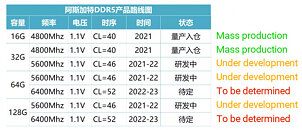Tuesday, April 27th 2021
Chinese Manufacturer Asgard to Launch DDR5 128 GB, 5,600 MHz Sticks As Early as 2022
Chinese company Jiahe Jinwei owns a sub-brand of gaming-oriented products named after Norse mythology - Asgard. The company has now announced that the trial production for high-speed DDR5 modules using Micron's semiconductors has completed without issue, meaning that their roadmap is going through without a hitch. Of course, as with the introduction of any new DDR memory standard, operating frequencies are still in their nascent stage; Asgard currently is only offering 4,800 MHz DDR5 sticks, which the most premium DDR4 sticks can already surpass.
It's only a matter of time before DDR5 speeds accelerate however, and Asgard is already planning to launch 5600 MHz DDR5 kits as early as 2022. These should be available in 32 GB and 128 GB capacities with a CAS latency of 46 cycles. The next step in performance increase would look towards 6,400 MHz kits, but these should only be expected towards the end of 2022 and beginning of 2023, should the development continue to move along smoothly. All of the DDR5 memory speeds should still make do with a relatively puny 1.1 V.
Sources:
ITHome, via Videocardz
It's only a matter of time before DDR5 speeds accelerate however, and Asgard is already planning to launch 5600 MHz DDR5 kits as early as 2022. These should be available in 32 GB and 128 GB capacities with a CAS latency of 46 cycles. The next step in performance increase would look towards 6,400 MHz kits, but these should only be expected towards the end of 2022 and beginning of 2023, should the development continue to move along smoothly. All of the DDR5 memory speeds should still make do with a relatively puny 1.1 V.



27 Comments on Chinese Manufacturer Asgard to Launch DDR5 128 GB, 5,600 MHz Sticks As Early as 2022
A minimum of 4800MHz will be great for their gaming-oriented products, although the CL40 latency is a bit less gamer-oriented.
Why would I go from 4000 at CL15 to this :eek:
I clearly remember when DDR4 came out. Same thing. I was using DDR3 at 2400 MHz at CL9 back then. DDR4 was 2400-2933 at CL14-18 or so IIRC.
"A CAS latency of 50 just means 50 clock cycles between addressing a column and when the data becomes available. DDR5-10000 has an I/O bus clock of 5 GHz and a DRAM clock of 1.25 GHz, so 50 cycles equates to 40 nanoseconds. For something like DDR4-2400, this time period would be equivalent to a CAS latency of 12. In other words, if DDR5-10000 did have a tCAS of 50, then that would be perfectly okay."
People see 40ns or 50ns and freak out because "OmG tHaTs So HiGh!"
That is why I said 'FULL' ECC.
If I understand it correctly "what determines absolute latency (and thus system performance) is determined by both the timings and the memory clock frequency. When translating memory timings into actual latency, it is important to note that timings are in units of clock cycles, which for double data rate memory is half the speed of the commonly quoted transfer rate. Without knowing the clock frequency it is impossible to state if one set of timings is "faster" than another.
For example, DDR3-2000 memory has a 1000 MHz clock frequency, which yields a 1 ns clock cycle. With this 1 ns clock, a CAS latency of 7 gives an absolute CAS latency of 7 ns. Faster DDR3-2666 memory (with a 1333 MHz clock, or 0.75 ns per cycle) may have a larger CAS latency of 9, but at a clock frequency of 1333 MHz the amount of time to wait 9 clock cycles is only 6.75 ns. It is for this reason that DDR3-2666 CL9 has a faster absolute CAS latency than DDR3-2000 CL7 memory."
So 6400MHz CL=52 DDR5 would give us 8.125ns, far worse than lets say DDR4-4000 CL16 (=4ns)?
Will DDR5 come down to more respectable timings over time, cause I don't see a reason why even bother with higher frequencies if CL has to be raised so much (it kind of kills the purpose)?
CL40 is a bit much, ~CL30 would be in line with what DDR4 have today, assuming the timings work the same way.But what JEDEC compliant timings will they reach?But that's heavily overclocked.
Same will be true for DDR5; Clockspeed and timings improve alot in the first few years, I am def not buying 1st generation DDR5.